HONDA ODYSSEY 1999 Owners Manual
Manufacturer: HONDA, Model Year: 1999, Model line: ODYSSEY, Model: HONDA ODYSSEY 1999Pages: 343, PDF Size: 3.73 MB
Page 241 of 343
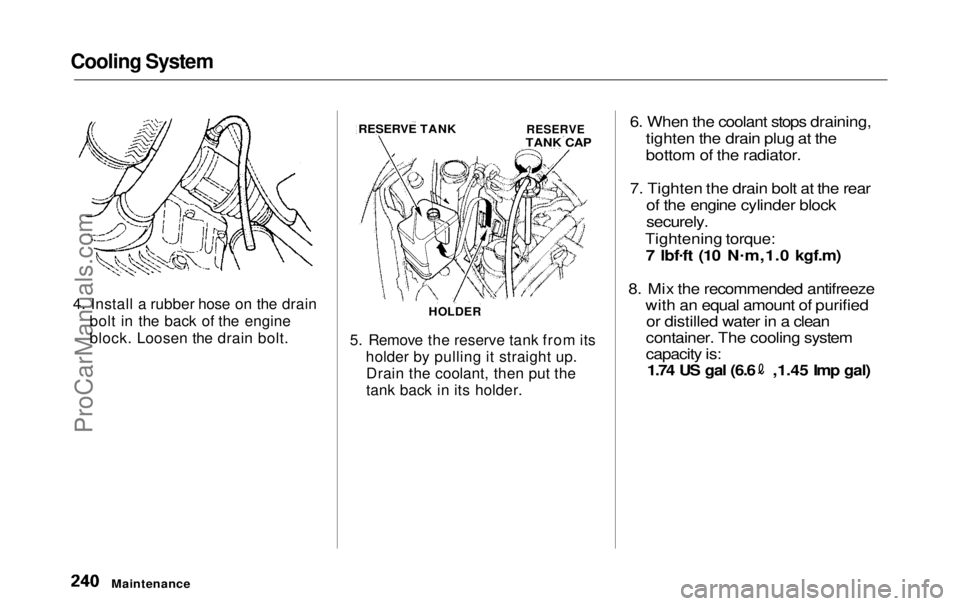
Cooling System
4. Install a rubber hose on the drain bolt in the back of the engine
block. Loosen the drain bolt. 5. Remove the reserve tank from its
holder by pulling it straight up.Drain the coolant, then put the
tank back in its holder.
6. When the coolant stops draining,
tighten the drain plug at the
bottom of the radiator.
7. Tighten the drain bolt at the rear of the engine cylinder block
securely.
Tightening torque: 7 lbf .
ft (10 N .
m,1.0 kgf.m)
8. Mix the recommended antifreeze with an equal amount of purifiedor distilled water in a clean
container. The cooling system
capacity is: 1.74 US gal (6.6 ,1.45 Imp gal)
Maintenance RESERVE TANK
HOLDER
RESERVE
TANK CAPProCarManuals.comMain Menu Table of Contents s t
Page 242 of 343
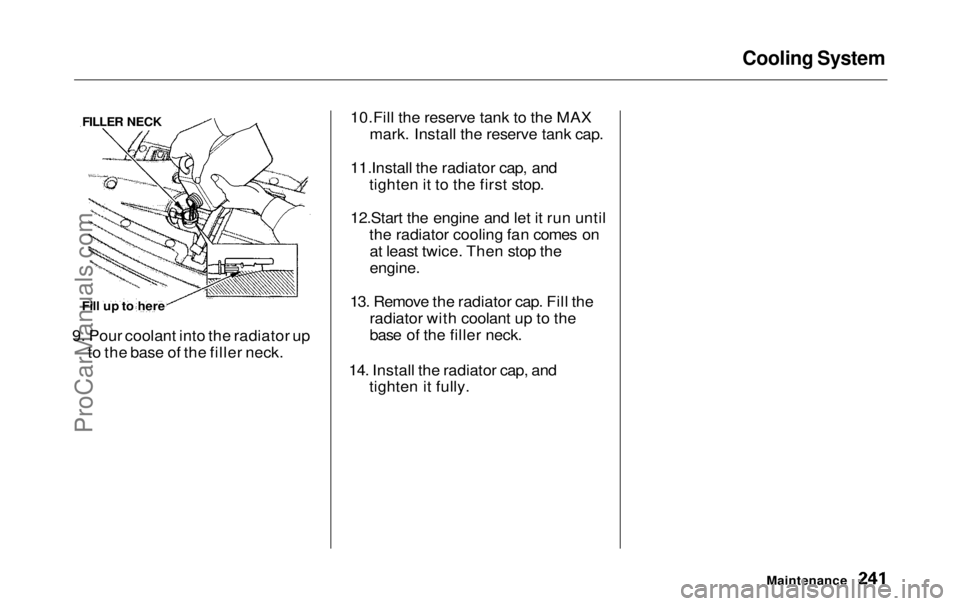
Cooling System
9. Pour coolant into the radiator up to the base of the filler neck. 10.Fill the reserve tank to the MAX
mark. Install the reserve tank cap.
11.Install the radiator cap, and tighten it to the first stop.
12.Start the engine and let it run until the radiator cooling fan comes onat least twice. Then stop the
engine.
13. Remove the radiator cap. Fill the radiator with coolant up to the
base of the filler neck.
14. Install the radiator cap, and tighten it fully.
Maintenance
FILLER NECK
Fill up to hereProCarManuals.comMain Menu Table of Contents s t
Page 243 of 343
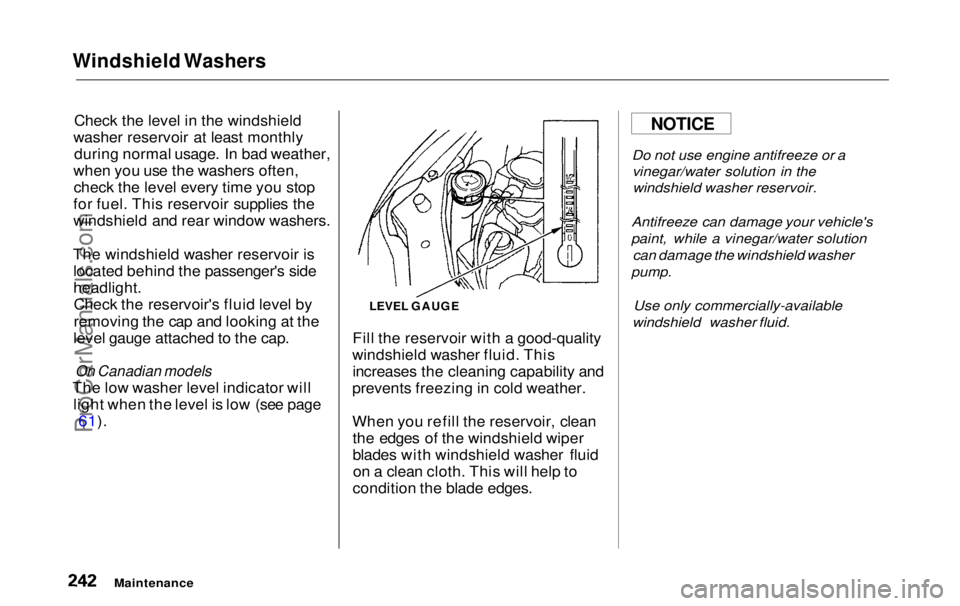
Windshield Washers
Check the level in the windshield
washer reservoir at least monthly during normal usage. In bad weather,
when you use the washers often, check the level every time you stop
for fuel. This reservoir supplies the
windshield and rear window washers.
The windshield washer reservoir is located behind the passenger's side
headlight.Check the reservoir's fluid level by
removing the cap and looking at the
level gauge attached to the cap.
On Canadian models
The low washer level indicator will light when the level is low (see page
61).
Fill the reservoir with a good-quality
windshield washer fluid. This increases the cleaning capability and
prevents freezing in cold weather.
When you refill the reservoir, clean the edges of the windshield wiper
blades with windshield washer fluidon a clean cloth. This will help to
condition the blade edges.
Do not use engine antifreeze or a
vinegar/water solution in thewindshield washer reservoir.
Antifreeze can damage your vehicle's
paint, while a vinegar/water solution
can damage the windshield washer
pump.
Use only commercially-available
windshield washer fluid.
Maintenance
LEVEL GAUGE
NOTICEProCarManuals.comMain Menu Table of Contents s t
Page 244 of 343
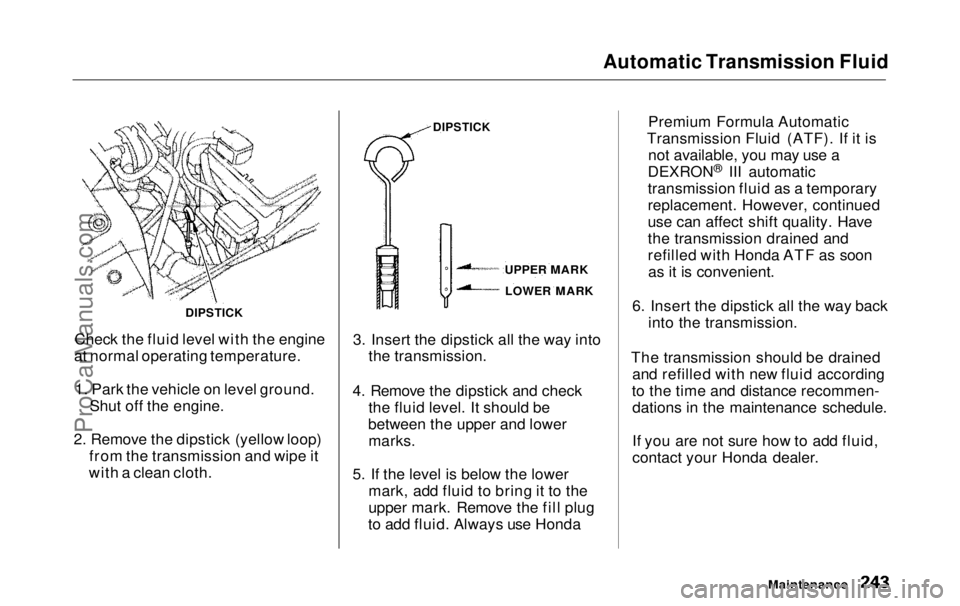
Automatic Transmission Fluid
Check the fluid level with the engine
at normal operating temperature.
1. Park the vehicle on level ground. Shut off the engine.
2. Remove the dipstick (yellow loop) from the transmission and wipe it
with a clean cloth. 3. Insert the dipstick all the way into
the transmission.
4. Remove the dipstick and check the fluid level. It should be
between the upper and lower marks.
5. If the level is below the lower mark, add fluid to bring it to the
upper mark. Remove the fill plug
to add fluid. Always use Honda Premium Formula Automatic
Transmission Fluid (ATF). If it is not available, you may use a
DEXRON
®
III automatic
transmission flui d
as a temporary
replacement. However, continued
use can affect shift quality. Have
the transmission drained and
refilled with Honda ATF as soon as it is convenient.
6. Insert the dipstick all the way back into the transmission.
The transmission should be drained and refilled with new fluid according
to the time and distance recommen- dations in the maintenance schedule.
If you are not sure how to add fluid,
contact your Honda dealer.
Maintenance
DIPSTICK
DIPSTICK
UPPER MARKLOWER MARKProCarManuals.comMain Menu Table of Contents s t
Page 245 of 343
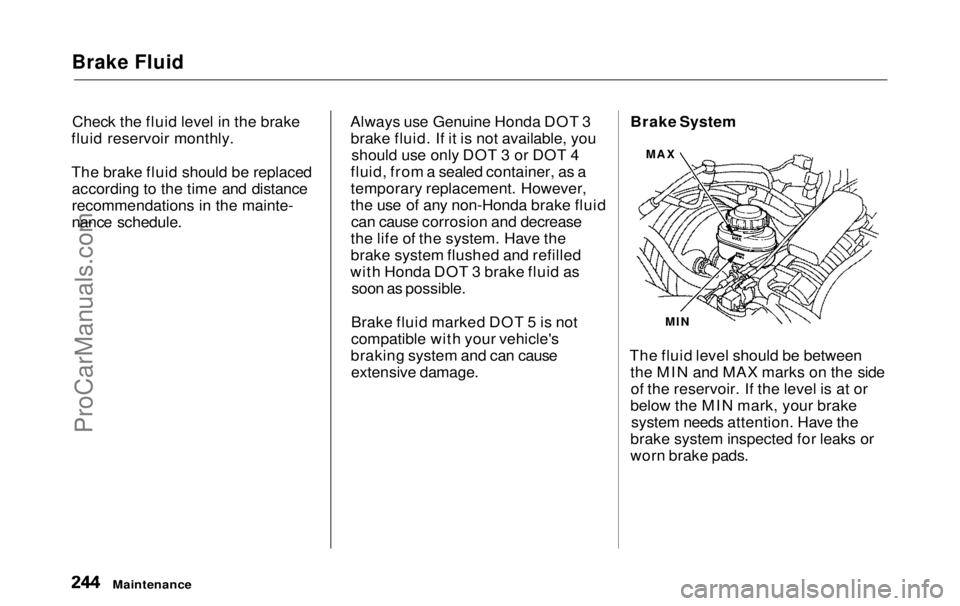
Brake Fluid
Check the fluid level in the brake
fluid reservoir monthly.
The brake fluid should be replaced according to the time and distance
recommendations in the mainte-
nance schedule. Always use Genuine Honda DOT 3
brake fluid. If it is not available, you should use only DOT 3 or DOT 4
fluid, from a sealed container, as a
temporary replacement. However,
the use of any non-Honda brake fluid can cause corrosion and decrease
the life of the system. Have the
brake system flushed and refilled
with Honda DOT 3 brake fluid as soon as possible.
Brake fluid marked DOT 5 is not
compatible with your vehicle's
braking system and can cause extensive damage. Brake System
The fluid level should be between the MIN and MAX marks on the sideof the reservoir. If the level is at or
below the MIN mark, your brake system needs attention. Have the
brake system inspected for leaks or
worn brake pads.
Maintenance
MAX
MINProCarManuals.comMain Menu Table of Contents s t
Page 246 of 343
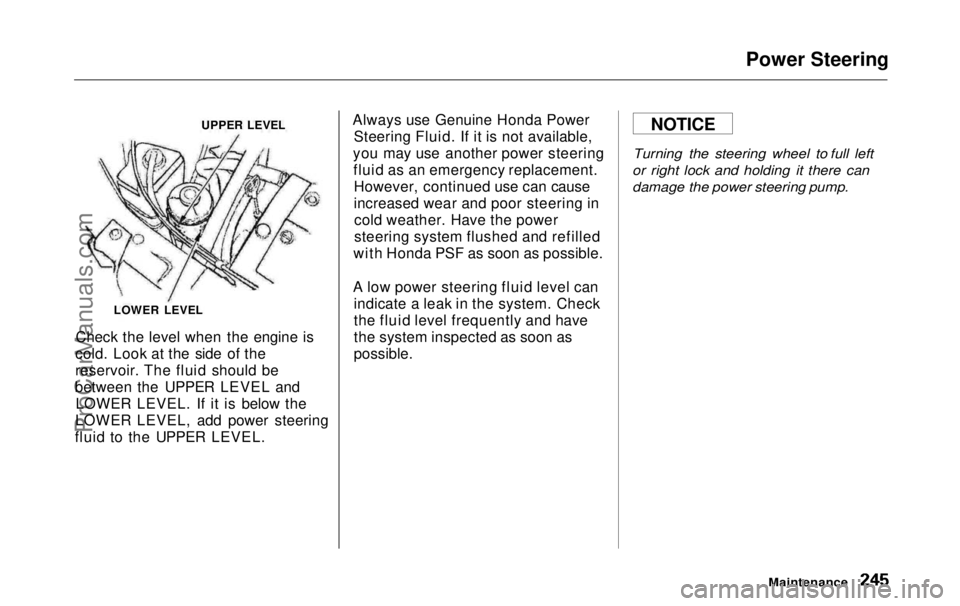
Power Steering
UPPER LEVEL
Check the level when the engine is
cold. Look at the side of the
reservoir. The fluid should be
between the UPPER LEVEL and LOWER LEVEL. If it is below the
LOWER LEVEL, add power steering
fluid to the UPPER LEVEL. Always use Genuine Honda Power
Steering Fluid. If it is not available,
you may use another power steering fluid as an emergency replacement.However, continued use can cause
increased wear and poor steering incold weather. Have the power
steering system flushed and refilled
with Honda PSF as soon as possible.
A low power steering fluid level can indicate a leak in the system. Check
the fluid level frequently and have
the system inspected as soon as
possible.
Turning the steering wheel to full left
or right lock and holding it there can
damage the power steering pump.
Maintenance
LOWER LEVEL
NOTICEProCarManuals.comMain Menu Table of Contents s t
Page 247 of 343
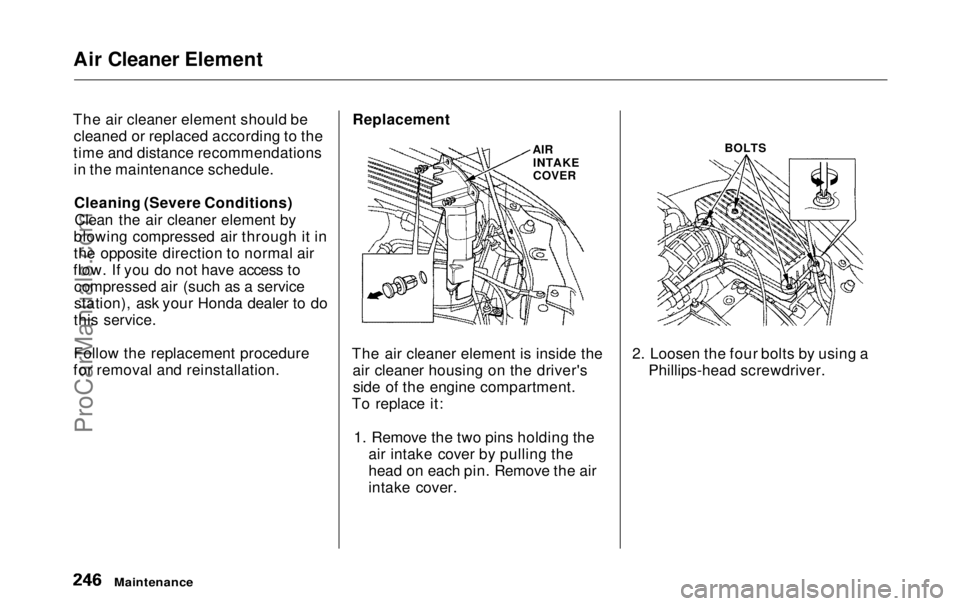
Air Cleaner Element
The air cleaner element should be cleaned or replaced according to the
time and distance recommendations in the maintenance schedule.
Cleaning (Severe Conditions)Clean the air cleaner element by
blowing compressed air through it in
the opposite direction to normal air
flow. If you do not have access to compressed air (such as a service
station), ask your Honda dealer to do
this service.
Follow the replacement procedure
for removal and reinstallation. Replacement
The air cleaner element is inside the air cleaner housing on the driver'sside of the engine compartment.
To replace it:
1. Remove the two pins holding the air intake cover by pulling the
head on each pin. Remove the air
intake cover. 2. Loosen the four bolts by using a
Phillips-head screwdriver.
Maintenance
AIR
INTAKE
COVER BOLTSProCarManuals.comMain Menu Table of Contents s t
Page 248 of 343
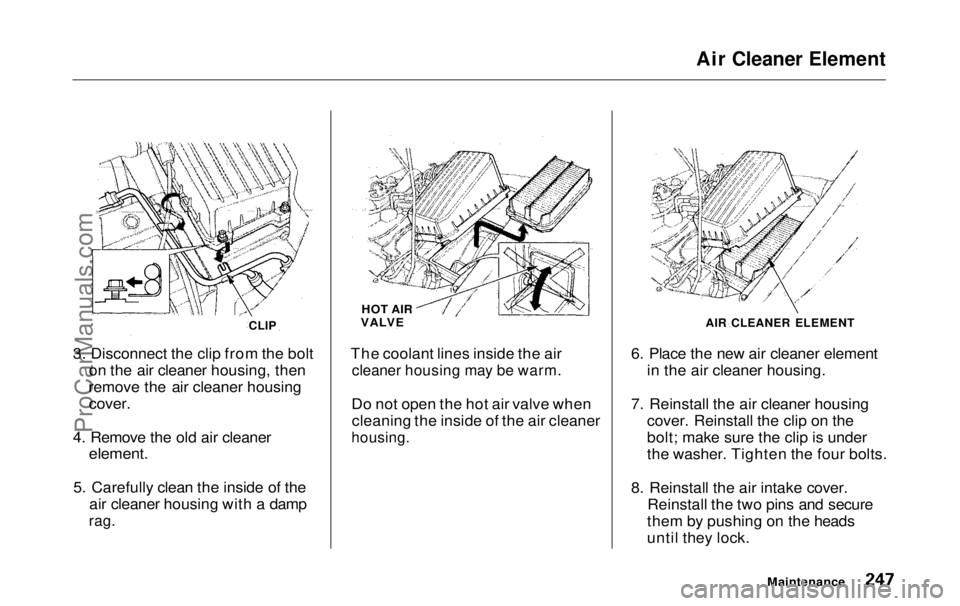
Air Cleaner Element
3. Disconnect the clip from the bolt on the air cleaner housing, then
remove the air cleaner housing
cover.
4. Remove the old air cleaner
element.
5. Carefully clean the inside of the air cleaner housing with a damp
rag.
The coolant lines inside the air
cleaner housing may be warm.
Do not open the hot air valve when cleaning the inside of the air cleaner
housing.
6. Place the new air cleaner element
in the air cleaner housing.
7. Reinstall the air cleaner housing cover. Reinstall the clip on the
bolt; make sure the clip is under
the washer. Tighten the four bolts.
8. Reinstall the air intake cover. Reinstall the two pins and secure
them by pushing on the heads
until they lock.
Maintenance
CLIP
HOT AIR
VALVE
AIR CLEANER ELEMENTProCarManuals.comMain Menu Table of Contents s t
Page 249 of 343
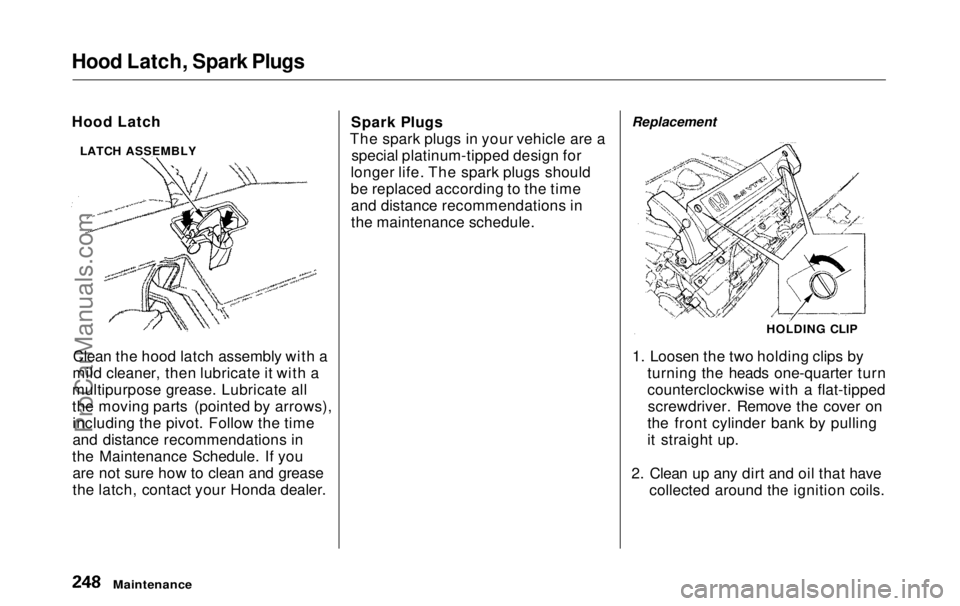
Hood Latch, Spark Plugs
Hood Latch
Clean the hood latch assembly with a
mild cleaner, then lubricate it with a
multipurpose grease. Lubricate all
the moving parts (pointed by arrows), including the pivot. Follow the time
and distance recommendations in
the Maintenance Schedule. If you are not sure how to clean and grease
the latch, contact your Honda dealer. Spark Plugs
The spark plugs in your vehicle are a special platinum-tipped design for
longer life. The spark plugs should
be replaced according to the time and distance recommendations in
the maintenance schedule. Replacement
1. Loosen the two holding clips by turning the heads one-quarter turn
counterclockwise with a flat-tippedscrewdriver. Remove the cover on
the front cylinder bank by pulling
it straight up.
2. Clean up any dirt and oil that have collected around the ignition coils.
Maintenance
LATCH ASSEMBLY
HOLDING CLIPProCarManuals.comMain Menu Table of Contents s t
Page 250 of 343
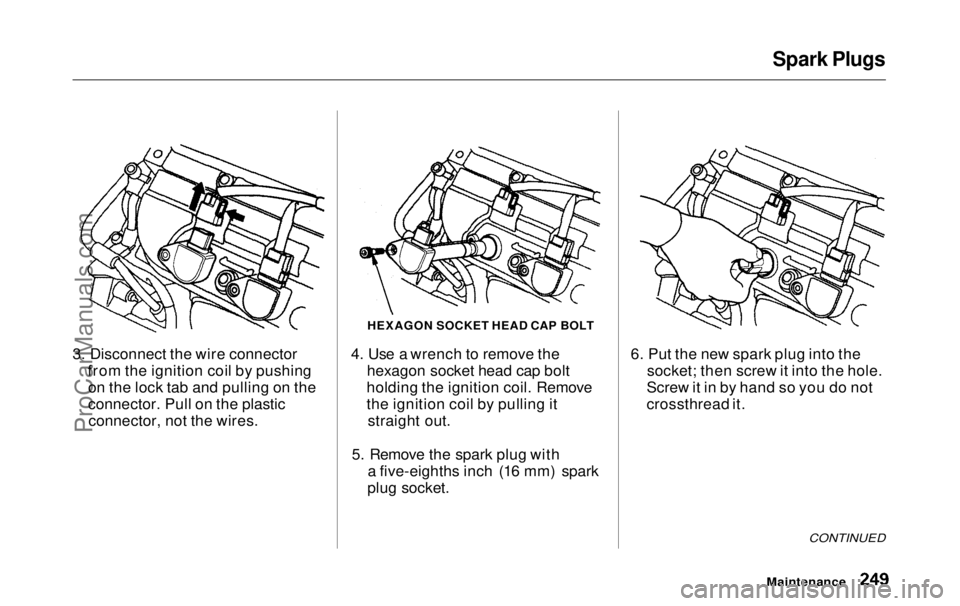
Spark Plugs
3. Disconnect the wire connector from the ignition coil by pushingon the lock tab and pulling on the
connector. Pull on the plasticconnector, not the wires. 4. Use a wrench to remove the
hexagon socket head cap bolt
holding the ignition coil. Remove
the ignition coil by pulling it straight out.
5. Remove the spark plug with a five-eighths inch (16 mm) spark
plug socket. 6. Put the new spark plug into the
socket; then screw it into the hole.
Screw it in by hand so you do not
crossthread it.
CONTINUED
Maintenance
HEXAGON SOCKET HEAD CAP BOLTProCarManuals.comMain Menu Table of Contents s t